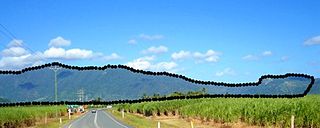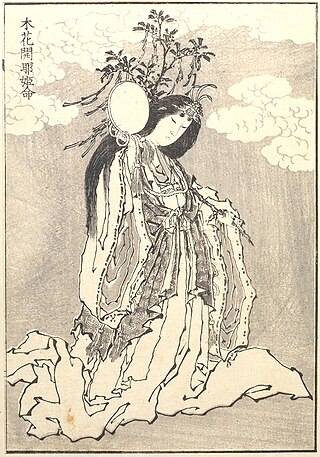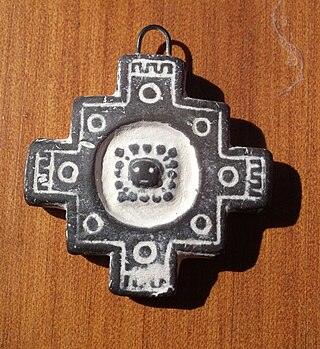Related Research Articles

Minerva is the Roman goddess of wisdom, justice, law, victory, and the sponsor of arts, trade, and strategy. Minerva is not a patron of violence such as Mars, but of strategic war. From the second century BC onward, the Romans equated her with the Greek goddess Athena. Minerva is one of the three Roman deities in the Capitoline Triad, along with Jupiter and Juno.
The serpent, or snake, is one of the oldest and most widespread mythological symbols. The word is derived from Latin serpens, a crawling animal or snake. Snakes have been associated with some of the oldest rituals known to mankind and represent dual expression of good and evil.
Lenape mythology is the mythology of the Lenape people, an Indigenous peoples of the Northeastern Woodlands

Australian Aboriginal religion and mythology is the sacred spirituality represented in the stories performed by Aboriginal Australians within each of the language groups across Australia in their ceremonies. Aboriginal spirituality includes the Dreamtime, songlines, and Aboriginal oral literature.

Nüwa, also read Nügua, is the mother goddess of Chinese mythology. She is credited with creating humanity and repairing the Pillar of Heaven.

The Rainbow Serpent or Rainbow Snake is a common deity often seen as the creator God, known by numerous names in different Australian Aboriginal languages by the many different Aboriginal peoples. It is a common motif in the art and religion of many Aboriginal Australian peoples. Much like the typical mother goddess archetype, the Rainbow Serpent is no different. The Serpent creates land and diversity for the Aboriginal people but when disturbed can bring great chaos.

Konohanasakuya-hime is the goddess of Mount Fuji and all volcanoes in Japanese mythology; she is also the blossom-princess and symbol of delicate earthly life. She is often considered an avatar of Japanese life, especially since her symbol is the sakura.

Renuka, also known as Yellamma, is a Hindu goddess worshipped predominantly in the South Indian states of Karnataka, Tamil Nadu, Telangana, Kerala, Andhra Pradesh and western state of Maharashtra. She is also known as the mother of Parashurama, the sixth avatar of the god Vishnu. Originally a Dravidian folk deity, she acquired the status of a mother goddess before eventually being associated with the legend of Parashurama.
In Australian Aboriginal mythology of the Bundjalung, an area known as "the land of the three rivers, "the Dirawong, an unseen spiritual creature also known as the goanna spirit, is one of the Creator Beings of the Bundjalung, that 1) Protects 2) Guards, 3) Battles the Rainbow Snake, 4) Helps the people with,

Snakes are a common occurrence in myths for a multitude of cultures. The Hopi people of North America viewed snakes as symbols of healing, transformation, and fertility. In other cultures snakes symbolized the umbilical cord, joining all humans to Mother Earth. The Great Goddess often had snakes as her familiars—sometimes twining around her sacred staff, as in ancient Crete—and they were worshipped as guardians of her mysteries of birth and regeneration. Although not entirely a snake, the plumed serpent, Quetzalcoatl, in Mesoamerican culture, particularly Mayan and Aztec, held a multitude of roles as a deity. He was viewed as a twin entity which embodied that of god and man and equally man and serpent, yet was closely associated with fertility. In ancient Aztec mythology, Quetzalcoatl was the son of the fertility earth goddess, Cihuacoatl, and cloud serpent and hunting god, Mixcoatl. His roles took the form of everything from bringer of morning winds and bright daylight for healthy crops, to a sea god capable of bringing on great floods. Where there are images of the sky serpent with its tail in its mouth, it is believed to be a reverence to the sun, for which Quetzalcoatl was also closely linked.
Brazilian mythology is the subset of Brazilian folklore with cultural elements of diverse origin found in Brazil, comprising folk tales, traditions, characters and beliefs regarding places, people, and entities. The category was originally restricted to indigenous elements, but has been extended to include:

Melanesian mythology refers to the folklore, myths, and religions of Melanesia, a region in Southwest Oceania that encompasses the archipelagos of New Guinea, the Torres Strait Islands, Solomon Islands, Vanuatu, New Caledonia and Fiji.
The legend of Trentren Vilu and Caicai Vilu (Kaikai) is a Mapuche flood myth that tells the story of a fierce battle between two mythical snakes, Trentren Vilu and Caicai Vilu. It explains how the Chilóe archipelago and mountains of southern Chile came to have its unique geography.

Inca mythology or religion includes many stories and legends that attempt to explain or symbolize Inca beliefs.

The mythology of Indonesia is very diverse, the Indonesian people consisting of hundreds of ethnic groups, each with their own myths and legends that explain the origin of their people, the tales of their ancestors and the demons or deities in their belief systems. The tendency to syncretize by overlying older traditions with newer foreign ideas has occurred. For example, the older ancestral mythology might be merged with foreign mythology, such as Hindu, Islam, or Christian biblical mythology.
References
- ↑ Saunders, Chas, and Peter J. Allen, eds. "EINGANA – the Australian Goddess of Creation (Australian mythology)." Godchecker. Godchecker.com / CID, 14 Jan. 2014. Web. 25 March 2016.
- ↑ "Eingana | Goddess a Day". Archived from the original on 14 March 2016. Retrieved 25 March 2016.
